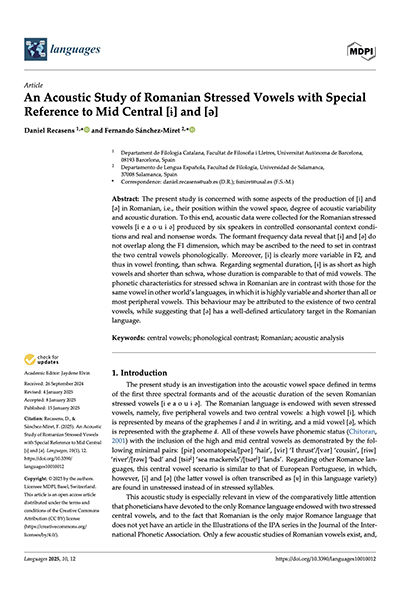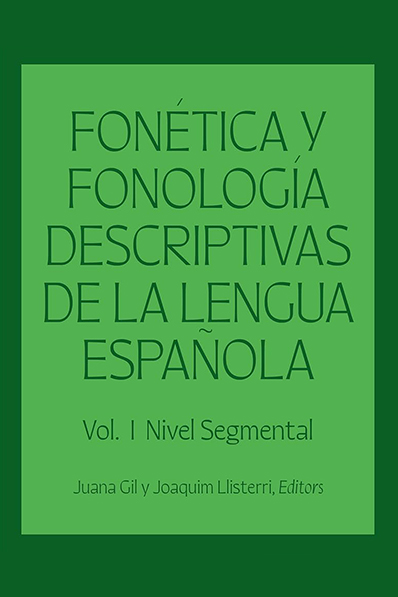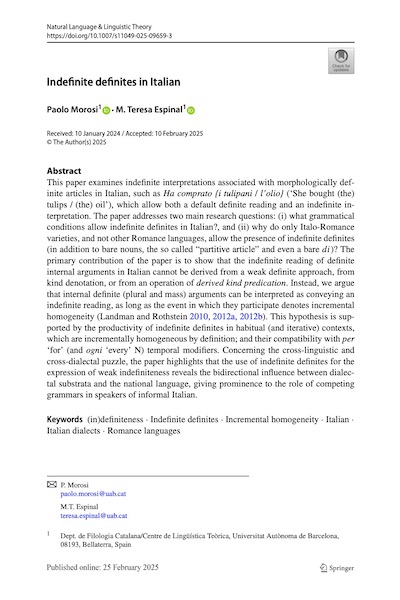21 gener, 2025

Autors:
Daniel Recasens & Fernando Sánchez‑Miret
Títol:
An Acoustic Analysis of VowelsEditorial: Languages, MDPI
Data de publicació: 2025
Pàgines: 19 Més informació
Text completThe present study is concerned with some aspects of the production of [ɨ] and [ə] in Romanian, i.e., their position within the vowel space, degree of acoustic variability and acoustic duration. To this end, acoustic data were collected for the Romanian stressed vowels [i e a o u ɨ ə] produced by six speakers in controlled consonantal context conditions and real and nonsense words. The formant frequency data reveal that [ɨ] and [ə] do not overlap along the F1 dimension, which may be ascribed to the need to set in contrast the two central vowels phonologically. Moreover, [ɨ] is clearly more variable in F2, and thus in vowel fronting, than schwa. Regarding segmental duration, [ɨ] is as short as high vowels and shorter than schwa, whose duration is comparable to that of mid vowels. The phonetic characteristics for stressed schwa in Romanian are in contrast with those for the same vowel in other world’s languages, in which it is highly variable and shorter than all or most peripheral vowels. This behaviour may be attributed to the existence of two central vowels, while suggesting that [ə] has a well-defined articulatory target in the Romanian language.
20 gener, 2025

Autors:
Lourdes Aguilar, Juana Gil Fernández (coord.) & Joaquim Llisterri (coord.).
Títol:
Fonética i fonología descriptivas de la lengua españolaEditorial: Georgetown University Press
Data de publicació: 2024
Més informacióLa descripción más actualizada y completa del sistema fonético y fonológico de la lengua española.
Aunque se ha investigado mucho sobre fonética y fonología del español, hasta ahora no existía ninguna obra de referencia descriptiva exhaustiva y completa. Fonética y fonología descriptivas de la lengua española Volúmenes 1 y 2 es una obra de referencia exhaustiva, escrita en español, que describe la fonética y la fonología del español. Editado por Juana Gil Fernández y Joaquim Llisterri, este conjunto ofrece una visión de conjunto para comprender los temas segmentales y suprasegmentales de la fonología española, dejando claro lo que hace falta seguir investigando.
El conjunto internacional de colaboradores de esta referencia esencial presenta pruebas nunca antes analizadas, introduce nuevos conceptos teóricos y cuestiones no consideradas anteriormente, amplía el alcance de los estudios de casos y organiza sus numerosos subtemas, además de sugerir nuevos temas para futuras investigaciones. Este libro, una referencia descriptiva con abundantes figuras y tablas, es la clave de los supuestos del campo y una presentación de la investigación aceptada en la que se basan los futuros estudios. Con información de vanguardia sobre todos los temas relacionados con los sonidos del español, Fonética y fonología descriptivas de la lengua española será un valioso recurso para investigadores, estudiantes y estudiosos de la lingüística española que deseen profundizar en el conocimiento de las características fonéticas y fonológicas de todas las variedades de la lengua española.
5 febrer, 2025

Autors:
Real, Espinal & Villalba
Títol:
Vaya in Spanish. From a judgment to a commitment markerEditorial: Journal of Historical Syntax
Data de publicació: 05-02-2025
Pàgines: 26 Més informació
Text completIn this paper we show the diachronic development of Spanish vaya, which goes from a form of the motion verb ir ‘to go’ to an epistemic verbal discourse marker (VDM) associated with the speaker's judgment regarding a proposition (e.g. ¡Vaya! ‘Wow!’ or ¡Vaya que es donoso! ‘How funny you are!’), and then to a VERUM marker (Leonetti & Escandell-Vidal 2009, Gutzmann, Hartmann & Matthewson 2017) encoding the speaker's strong commitment to the truth of a proposition (e.g ¡Vaya si se casa! ‘You bet he's getting married!’). We argue that this shift is a clear case of a run-of-the-mill process of grammaticalization involving three stages and each change corresponds to a different position of vaya in the articulated Speech Act layer advocated by Manfred Krifka (2021). When vaya expresses a subjective epistemic attitude of the speaker, it is postulated in J(udgement)P(hrase), a position associated with epistemicity and evidentiality; when vaya expresses a strong commitment of the speaker to the truth of the proposition it precedes (i.e., a VERUM marker), it is postulated in the higher Com(mitment)P(hrase). All in all, this study argues that the grammaticalization path of vaya is not only unidirectional (against previous analysis like Octavio de Toledo y Huerta 2001 and Company Company 2008), but rather obligatorily implies a bottom-up reanalysis (Roberts & Roussou 2003).
26 febrer, 2025

Autors:
Morosi & Espinal
Títol:
Indefinite definites in ItalianEditorial: Natural Language & Linguistic Theory
Data de publicació: 25-02-2025
Pàgines: 38 Més informació
Text completThis paper examines indefinite interpretations associated with morphologically definite articles in Italian, such as Ha comprato {i tulipani / l’olio} (‘She bought (the) tulips / (the) oil’), which allow both a default definite reading and an indefinite interpretation. The paper addresses two main research questions: (i) what grammatical conditions allow indefinite definites in Italian?, and (ii) why do only Italo-Romance varieties, and not other Romance languages, allow the presence of indefinite definites (in addition to bare nouns, the so called “partitive article” and even a bare di)? The primary contribution of the paper is to show that the indefinite reading of definite internal arguments in Italian cannot be derived from a weak definite approach, from kind denotation, or from an operation of derived kind predication. Instead, we argue that internal definite (plural and mass) arguments can be interpreted as conveying an indefinite reading, as long as the event in which they participate denotes incremental homogeneity (Landman and Rothstein 2010, 2012a, 2012b). This hypothesis is supported by the productivity of indefinite definites in habitual (and iterative) contexts, which are incrementally homogeneous by definition; and their compatibility with per ‘for’ (and ogni ‘every’ N) temporal modifiers. Concerning the cross-linguistic and cross-dialectal puzzle, the paper highlights that the use of indefinite definites for the expression of weak indefiniteness reveals the bidirectional influence between dialectal substrata and the national language, giving prominence to the role of competing grammars in speakers of informal Italian.
27 febrer, 2025

Autors:
Gemma Repiso-Puigdelliura
Títol:
Development of Vowel Intrusion in Spanish Heritage SpeakersEditorial: Language and Speech
Data de publicació: 27-02-2025
Més informacióThis study investigates the sound system of heritage speakers (henceforth, HSs) as they shift dominance from their heritage language to their majority language. Specifically, it analyzes the production of intrusive vowels in Spanish consonant clusters across the lifespan of HSs, focusing on tautosyllabic clusters (i.e., /Cɾ/) and heterosyllabic clusters (i.e., /ɾ.C/). Semi-spontaneous speech was elicited from three age groups of Spanish HSs—younger children, older children, and adults—for whom American English is the majority language, as well as from three age-matched groups of non-heritage Spanish speakers raised in Mexico. The presence and duration of intrusive vowels were examined, with the latter calculated as a ratio of intrusive vowel duration to tap duration. Overall, the results indicate that all speaker groups more frequently produce consonant clusters with intrusive vowels than without. However, Spanish HSs produced fewer and shorter intrusive vowels compared with their non-heritage counterparts. In addition, heritage and non-heritage speakers exhibited a lower rate of intrusive vowel production in the 5-to-8 -year-old group compared with adults. Despite this, the absence of an interaction between age group and speaker type suggests a parallel pattern of change in intrusive vowel production across all ages. Voicing emerged as the most consistent phonetic factor, predicting a higher rate of intrusive vowels with a longer duration relative to the tap.











